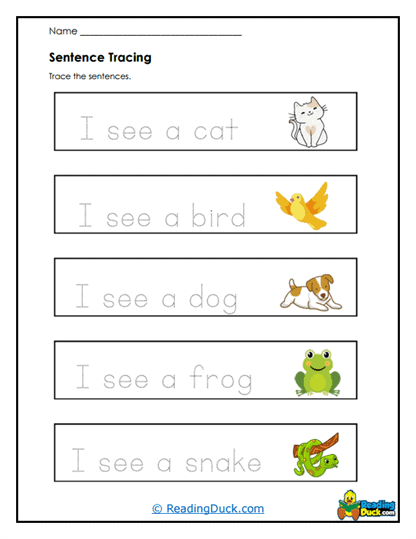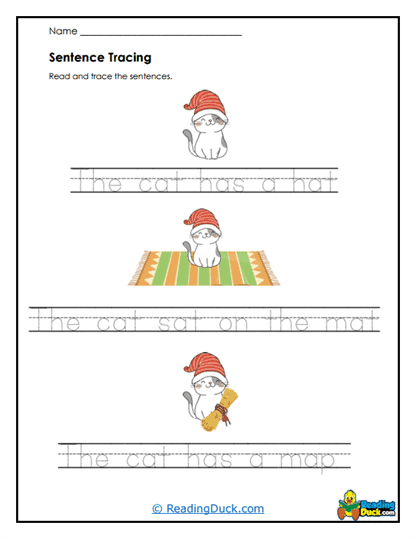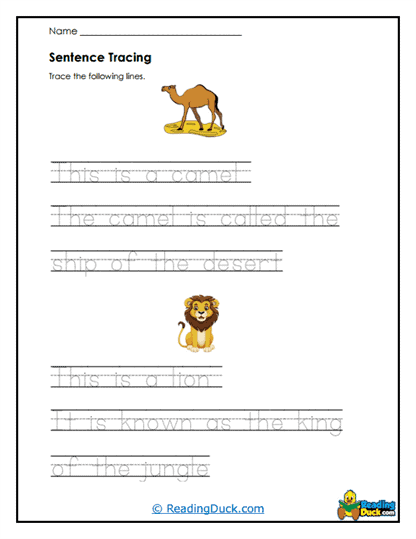Sentence Tracing Worksheets
About Our Sentence Tracing Worksheets
This collection of worksheets can help young learners practice handwriting and familiarize themselves with sentence structure. These worksheets typically feature pre-written sentences in a dotted or faintly outlined font that students can trace over. By tracing sentences, children develop foundational skills in handwriting, allowing them to recognize and replicate letters, words, and sentences with improved control and clarity.
Layout of Our Worksheets
Line Spacing - Adequate spacing between lines guides students to form letters correctly without crowding. This spacing gives young learners room to shape letters accurately without feeling cramped, which is particularly helpful for those still mastering control over their handwriting movements. With the right spacing, students can see the distinct boundaries of each line, making it easier to keep letters aligned and sized appropriately. As they develop comfort with this layout, they can transition to narrower lines with more confidence, showing progress in their handwriting precision.
Font Style - Often in a dashed or dotted style, the letters are typically large enough for easy tracing, supporting early learners who are still developing fine motor control. The size and dashed format of these fonts allow students to follow letter shapes in a structured way, reinforcing proper letter formation without overwhelming them with smaller text. This style not only makes tracing easier but also helps children recognize and remember each letter's structure. By repeatedly tracing these larger, guided letters, students build a visual and physical memory of each form, aiding future writing tasks where guidance lines are no longer present.
Guidance Marks - Arrows or numbers may accompany each letter, guiding students on where to start and finish each stroke. These marks are particularly helpful for young learners who are still unfamiliar with the sequence of strokes needed to form letters accurately and consistently. By following numbered steps or directional arrows, students can develop a consistent, fluid writing style that will serve them well as they progress to independent writing. This approach also minimizes confusion, helping them avoid common beginner mistakes, like writing letters from the bottom up or reversing strokes.
These carefully structured layouts ensure that children focus on accuracy and consistency in their writing, reinforcing essential handwriting principles in a clear and enjoyable format.
Practical Steps for Effective Use
Choose Appropriate Writing Tools - Encourage students to use pencils or erasable markers, as they allow for corrections. For beginners, these tools provide the flexibility to erase mistakes, reducing frustration and encouraging persistence. Thicker pencils or markers, particularly for younger learners, help them maintain a steady grip, making it easier to control strokes and follow traced lines. This focus on the right tools fosters a positive writing experience, allowing children to learn without feeling restricted by minor errors.
Tracing and Repetition - Students can trace the same sentence multiple times to reinforce muscle memory and sentence structure. This repetition helps students internalize the shapes and patterns of letters, making it easier to recall them when writing independently. Tracing also instills a sense of rhythm and flow, essential for achieving fluid handwriting as students advance. Over time, this repeated practice builds confidence, allowing children to write more comfortably and accurately on their own.
Visual Cues - Utilize visual cues provided on the worksheet (e.g., directional arrows) to guide the correct stroke sequence for each letter. These cues serve as a step-by-step roadmap, helping students understand the correct order and direction of strokes for each letter. For beginners, visual aids make the process of learning letters less daunting, breaking it into manageable steps. By following these cues consistently, students develop the habit of forming letters correctly from the start, which is essential for efficient and neat handwriting later on.
Tips for Teachers and Parents
Correct Posture - Ensure students sit comfortably with feet flat on the ground and maintain an upright posture, which supports better hand movement and reduces strain. This posture helps students maintain control over their writing movements, making it easier to form consistent letters without undue hand or wrist fatigue. An upright position also aligns the head and neck comfortably over the paper, reducing the likelihood of discomfort and encouraging longer writing sessions. Practicing good posture early on builds healthy habits that students can carry forward into their academic and personal lives.
Pencil Grip - Teach children the tripod grip - using the thumb, index, and middle finger - for maximum control and precision. This grip provides a stable foundation, allowing for smoother and more deliberate movements that are essential for legible handwriting. Practicing the tripod grip can be particularly beneficial for young learners, as it helps reduce hand tension, allowing them to focus on forming letters rather than adjusting their grip. Over time, mastering this grip leads to more consistent handwriting quality and greater endurance during writing tasks.
Controlled Hand Movement - Guide students to use their whole hand rather than just fingers, which aids in creating smoother, more consistent strokes. Moving the hand as a unit allows for greater control over each letter, helping students avoid shaky or inconsistent lines. This approach also reduces strain on individual fingers, making writing less tiring for young learners who may struggle with motor control. Practicing full-hand movement helps establish a more efficient writing style that students can build upon as they grow and their writing demands increase.
These usage tips provide a foundation for children to write with confidence and precision, helping them to gradually progress from tracing to freehand writing.
The Benefits of Tracing Sentences
Handwriting Improvement and Muscle Memory
These worksheets are invaluable in refining students’ handwriting. Tracing repeated sentences instills muscle memory, where students gradually learn to produce letter shapes and sentences without constant guidance. This practice strengthens muscle control and coordination, essential for clear and steady handwriting. With continued tracing practice, students begin to naturally adjust their letter sizes, spacing, and alignment, leading to improved legibility and overall neatness. The repetitive nature of tracing also reinforces the correct formation of each letter, which is particularly helpful for young learners who are new to writing. As students trace the same letters and words repeatedly, they develop an automaticity in their handwriting that allows them to focus less on the mechanics and more on content as they advance. This foundation of smooth, controlled writing movements will support their ability to write longer texts accurately and comfortably in later stages of learning.
Fine Motor Skills and Hand-Eye Coordination
Tracing also supports fine motor skill development, crucial for tasks that require precision, such as drawing and even everyday activities. As students trace each letter, they enhance hand-eye coordination, building the ability to follow visual guides accurately and apply appropriate pressure when writing. By refining these fine motor skills, students are better prepared not only for writing but also for other detailed tasks like cutting, coloring, and even typing. These worksheets provide a controlled environment where children can work on precision without feeling overwhelmed by the challenges of writing freehand. The focus on detail in tracing activities also helps students learn to control their hand movements in a focused way, laying the groundwork for more complex motor skills in the future. This progress translates to an improved ability to handle writing instruments and navigate visual spaces, which contributes to their success in a wide range of academic and life skills.
Reinforcement of Sentence Structure
Repeatedly tracing sentences introduces students to common sentence patterns, helping them recognize proper word order, punctuation, and spacing. This process establishes a firm foundation for written language comprehension and the ability to form coherent sentences independently. Through tracing, students gain familiarity with sentence elements like capitalization at the beginning and punctuation at the end, essential rules that support clearer written communication. This repeated exposure to sentence structure strengthens their grasp of syntax and language flow, laying the groundwork for stronger reading and writing skills. By internalizing these structural aspects, students are better equipped to compose sentences that are both grammatically correct and well-organized. This early foundation in sentence mechanics will support their language development as they progress to more complex writing tasks, making them more confident and effective communicators.
Internalizing Language Structure and Syntax
As children repeatedly trace sentences, they begin to internalize the structure of language, including syntax, grammar, and word order. This hands-on practice serves as an early introduction to sentence construction and can positively impact students’ future writing abilities, helping them feel more comfortable with sentence formation as they progress.
Tracing not only improves handwriting but also strengthens overall language comprehension. By focusing on sentences rather than isolated words, students learn to view language as a cohesive structure, becoming more comfortable with grammar and punctuation rules that are essential for effective written expression. This familiarity prepares students for more advanced language tasks, making sentence writing less daunting and more intuitive.
Long-term, consistent tracing practice is linked to marked improvements in handwriting quality. As students progress from tracing to independent writing, they retain the clarity, neatness, and fluidity cultivated during their tracing exercises. This muscle memory translates into confident, efficient writing that positively impacts their performance in academic settings.
Students with legible handwriting are often more engaged in classroom activities, as they can express ideas in writing without frustration or hesitation. Improved writing skills enable students to complete tasks more efficiently, participate actively in written exercises, and present their work proudly. These benefits support greater confidence, contributing to an overall positive learning experience.









